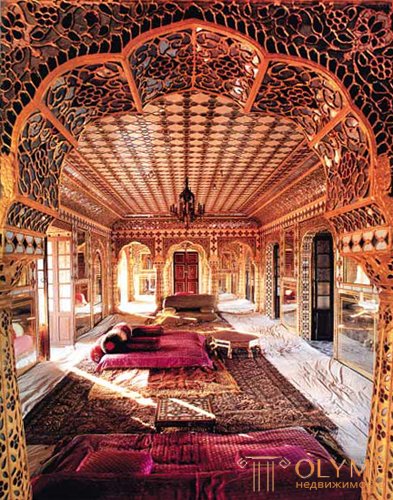
Indian style is a combination of luxury, gold, refinement and delicate taste with asceticism, modesty, simplicity of lines and shapes. Cocktail of ornaments, colors, patterns and textures, magnificent carved and inlaid furniture reflect the Indian style.
India is a country of spices, spices, aromas of cinnamon, sandalwood, cloves, cardamom, a country where the spiritual side of life means everything, where faith and religion are at the heart of the order and organization of all life.
The Indian style is a turquoise, crimson, orange color, and quite unique in its own way. Indian silk to the touch is not as smooth and slippery as Chinese, a little rough.
Furniture in Indian houses is low, hand-cut from a very durable teak wood. Sofas and beds should be soft and comfortable, relaxing to sleep. For the basis of the interior in Indian style, three to four pieces of furniture are enough, but they must be combined in color.
A characteristic feature is the easy transformation of the details of the house: chairs and tables, screens, shutters and doors often “change roles”.
Characteristic materials: wood - teak, ivory, mother of pearl, silver, brass, forged metal, feathers.
Techniques: enamel, forging, chasing, carving, inlay.
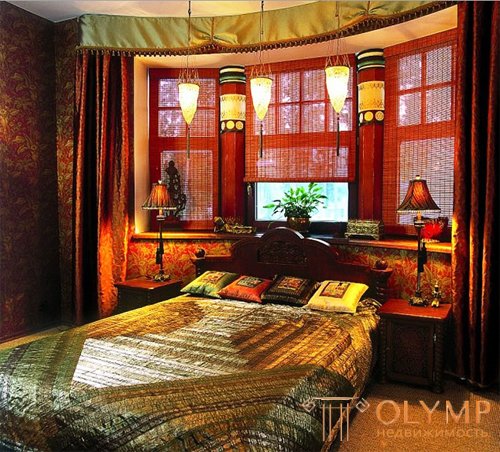
Indian style in the interior, photo
Indian style interior accessories:
The interaction of Eastern and Western cultures began long ago. The art of the Hindus evolved under the influence of Persian culture, adopting from it elements of Greek forms and traditional Muslim ornaments. We meet the techniques of ancient Indian carvers in later epochs in Portugal and Holland.
Because of its location, the Indians adopted a lot from the Persian ornament, many elements of the Greek style penetrated the Persians into India. At the same time, Indian art is very independent. Amazingly beautiful ornaments, numerous carvings are inherent in Indian style both in architectural elements and in furniture.
Around the IV century BC. e. The language of art forms has undergone profound changes. Greek elements were mixed with the Indian form-building elements, as a result of which a peculiar new world of forms arose.
The culture of India is one of the oldest in the world. The art of this country did not develop as rapidly as the European one; like Chinese, it was formed for a long time from different ethnic traditions. There are several stages in the history of Indian art:
Indian culture has its original forms, in any case, it was until the IV century BC. This century was a turning point in the development of Indian architecture and the Indian style in general - its architectural forms began to mix with the forms of other cultures, in particular with Greek culture.
In the view of Europeans not familiar with Indian style, it is presented as a mixture of fabrics, bright colors, candles, figurines, mirrors, and other attributes. By the way, the first stretch ceilings came from India - they were made from fabrics and hides. Whatever it was, but attributing excessive diversity to the Indian interior are wrong. Indeed, the Indian house is colorful, but it is not cloying, but, on the contrary, warm, cozy and “homely”. The Indian house, first of all, symbolizes hospitality.
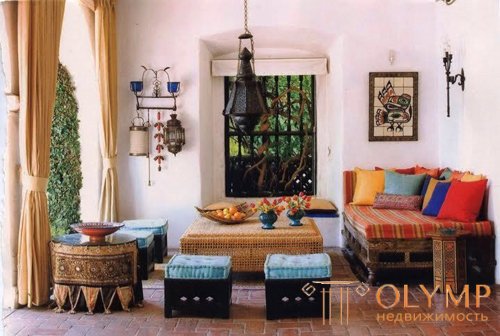
Indian style in the interior, photo
Talking about the Indian interior is probably better to start with color, since the choice of color
makes a huge difference. What colors are better to “attract” to decorate the interior of the home, how different colors will interact with each other and with interior items, and, most importantly, what impact they will have on the owners of the house, everything is taken into account.
Color, pattern are definitely the basic tools for creating an Indian style in a European home, which implies a bold palette. It happened traditionally and is common in Indian architectural culture. The most widely used in the Indian interior is a bright juicy green color. The color of the nutmeg pulp is reddish-orange - no less popular, as indeed, in general, all shades of red.
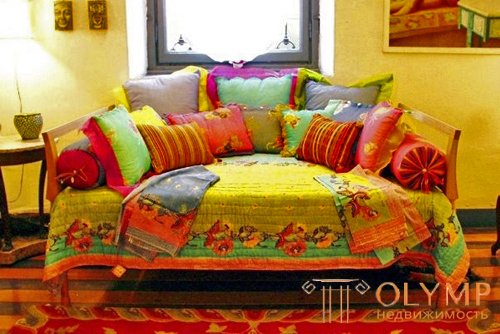
Indian style in the interior, photo
The walls are a large and best canvas for artistic experiments; they can be painted in yellow, gold, turquoise, light green in color, but they can also be neutral or in warmer earth tones — curry, dark brown, sandy.
In general, the Indian house is amazingly colorful. Red, turquoise, green and yellow are complemented by white and natural terracotta tones. But it is necessary to take into account the correct ratio of basic tones and natural. Colors should welcome rather than dominate.
Warm colors tend to "grab attention" and fill with presence. While cool shades are turquoise, greens create the illusion of open space.
Indian furnishing dictates the presence of natural printed fabrics with floral designs, animal designs or decorative, drop-shaped patterns, one of the names of which is “Indian cucumber”. Fabrics can "participate" as bedspreads, pillow covers, curtains or curtains, and it is they who will help, first of all, to create a style.
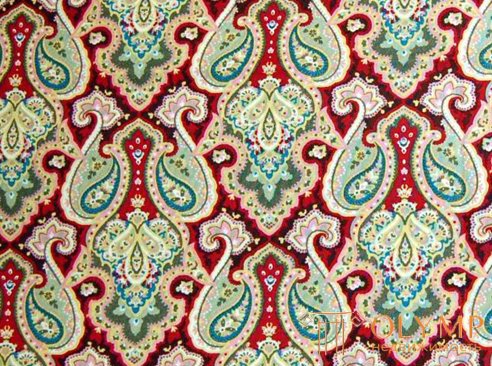
Indian style in the interior, photo
Decorative arches are a typical Indian architectural element that can be reproduced in mirrors and headboards.
Furniture in Indian houses is low, hand-cut from a very durable teak wood. Simple in shape, but richly decorated, Indian furniture reflects oriental patience and painstakingness. The technique of lacquering decorative items, intarsia of black pearl, ivory (Bombay mosaic), openwork carving are characteristic features of Indian interior and furniture.
Furniture for sitting - low stools, round chairs without a back with a pillow, benches like a modern sofa - so unpretentious that among its options there is a simple support for arms and head for a person in a squatting position. In the 19th century, Indian furniture was extremely popular in Europe.
The low primitive bed-frame on four legs with the supports passed through them is widespread. The plane for lying was wicker.
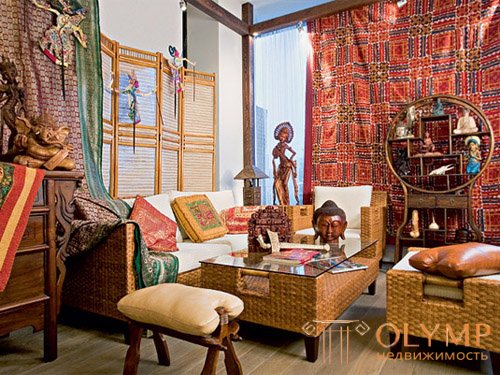
Indian style in the interior, photo
Such beds were made of expensive material and luxuriously decorated. Characteristically, the Indian product - a stool with twisted and varnished legs and a wicker seat. Indian luxury style involves the use of teak, rosewood, rattan and boxwood for the manufacture of furniture and other interior items.
Manual labor makes every detail, every design element unique in its own way. The color of furniture - from delicate natural shades to the darkest and most solid, the style - from primitive to the most sophisticated and elegant.
In India, rich in various resins, the varnishing technique and its application for decorative purposes were highly developed. One of the methods was varnishing with color fast-drying varnishes, mainly carved furniture elements. Another method is multi-layered varnishing with scratching a pattern on its surface like sgraffito.
Small-sized furniture items and drawers were made of papier-mâché and varnished in a rather complicated way. For the decoration of furniture used intarsia of ebony, mother of pearl, ivory (Bombay mosaic), as well as ivory carving.
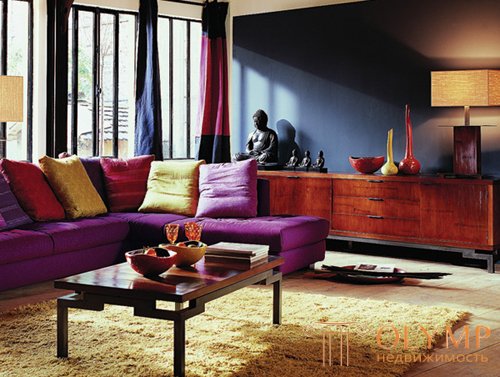
Indian style in the interior, photo
The primitive figurative “furniture product”, the support for the body, also testifies to the unpretentiousness of the Indians: the squatting fakir leans his hands and his head on the stand and sleeps quietly. However, at the same time, the Indians knew what comfort is, as evidenced by the ceremonial chair of a Buddhist monk, resembling in its design the ancient Indian throne.
Later, when the influence of Europe affected India, new requests emerged that revived the thousand-year-old mastery of the Hindus. There is a new, mixed style. In the XIX century in Europe there were many lovers of Indian furniture, which was purchased most often because of its lush exotic decor.
First of all, we were looking for furniture decorated with t. And. Bombay mosaic. All this led to the revival of Indian furniture art. New Indian furniture, although it began to acquire European forms, but thanks to the abundant Indian-Arabic ornamentation, it retained its distinctive Indian character.
The Indian style of furniture, despite the features alien to us, is interesting and very decorative. Along with careful elaboration of details, we are first of all impressed by the striking predilection of Asian peoples for pompousness and complex ornamentation, which is not always organically linked with the purpose of a particular product.
The lush openwork carving in Indian furniture art is evidence of the special passion of Hindus for decoration and decoration, they used any opportunity to decorate
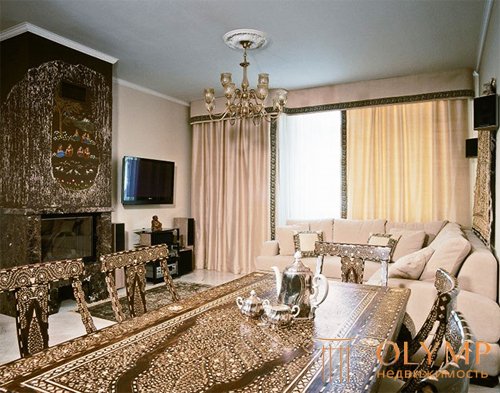
Indian style in the interior, photo
Indian gizmos make the house the necessary romance, a bit of spice and flavor of spices, the smell of distant wanderings and the dream of happiness. By the way, it is not at all necessary to make the interior entirely Indian, and it is even undesirable that you can easily overload the room, “over-decorate”.
It is best to choose a few of the objects closest to you and combine them with elements of modern furnishings. Two or three pieces of furniture will be enough to form the basis of the interior in Indian style. Well, if they will be combined with each other - at least in color (the most popular wood is teak, walnut or shisham).
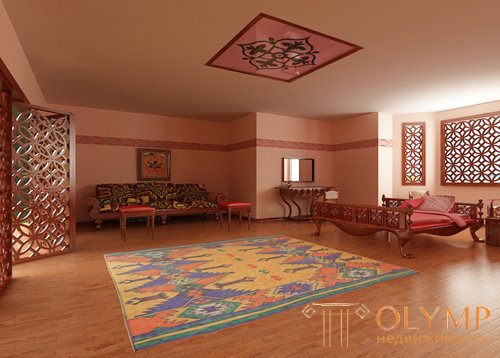
Indian style in the interior, photo
Since our eastern entourage is a kind of exotic game, it’s better if you choose the most expressive and distinctive Indian “things”.
Number one on this list is an Indian table (coffee, “coffee”) of a special style: low, with straight, thick legs, with a carved border around the perimeter, carved (or in-depth) squares in the middle, and most often with a glass table top. Such a table can also be decorated with bronze inserts or inlays.
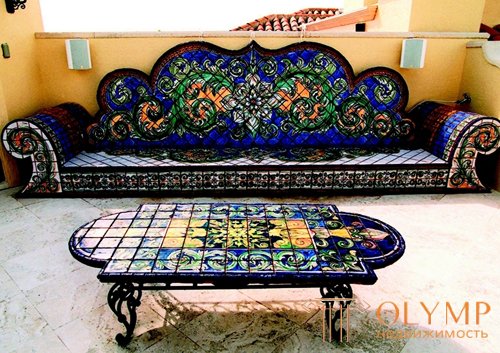
Indian style in the interior, photo
Unusual and purely Indian version - “matryoshka” of several tables (or stools) of different heights, which can be put one under another to save space. There are still pompous tables of black or white marble inlaid with precious or semi-precious stones - but with their help you risk turning your home into a pavilion for filming a movie about the life of the Maharajas.
Another possible feature of the Indian house is a low narrow closet with doors stylized under the shutters, decorated with wooden or metal inserts in the form of gratings (by the way, heavy carved teak wardrobe can be decorated in the same style).
If you want something more vivid and Indian, buy a bedside table, chest of drawers, painted in the so-called Rajasthan manner: figures of elephants and horses, girls in Indian clothes or scenes from the life of the gods.
In the artistic environment, there is a famous legend about the interchangeability of Indian doors and tables - as if you can convert one into another and vice versa, depending on your mood. Indeed, the principle of the door in the Indian house is the same as for the countertops: the maximum thread and inserts ornaments made of metal, mother of pearl, marble or stone.
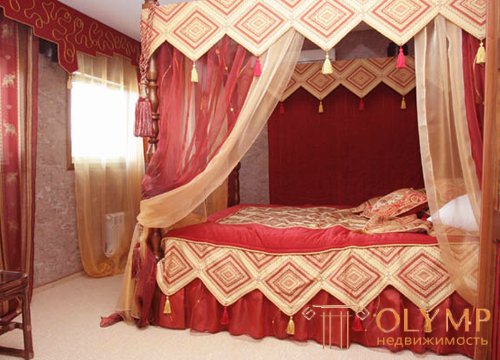
Indian style in the interior, photo
Connoisseurs of the East know that the fascination with wood inlays originated in India for a reason: in this way craftsmen tried to protect furniture and other wooden products from the humid climate and another local misfortune - termites wood lovers. Thanks to these two circumstances, today we have the most skilled examples of applied art.
In addition to the carved doors, in your Indian styling should be reserved a place for a screen - especially it will decorate the bedroom. Unlike a massive door, a screen can only be a hint of the division of space - so often Indian screens entirely consist of through-threading ornate carving (sometimes the openwork is supplemented with lacquer miniatures with images of flowers and fruits).

Indian style in the interior, photo
The selection of parts to create an Indian interior is unusually large. You can decorate the walls with silk carpets or hang panels on them from ornamental stones. Decorate the interior and plot mural bas-reliefs made up of wood species of different shades.
Multicolored pillows, chess made of sandalwood, hookahs, lamps made of multicolored glass, a mirror in a carved wooden frame in the form of closed sashes, forged chests, bells that drive away evil spirits, some kind of candelabrum floor candlestick - all this, lovingly collected into a collection, will create the atmosphere of a colonial indian house.
Do not forget to use animal figurines that Indians make from a variety of materials - they adore cows, as well as herons (human-sized), snakes, crocodiles, horses, antelopes and, of course, elephants.
Without elephants, the Indian interior will lose a good half of its charm! It is not necessary to arrange the elephants in rows on the dresser: as an alternative, you can purchase a glass table, the tabletop of which is supported by the figures of elephants.
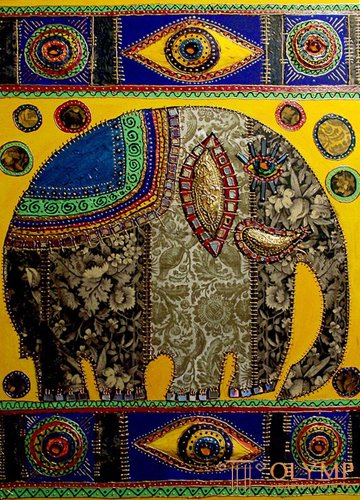
Indian style photo
The motley national dishes look very impressive: dishes for Indian pancakes, chapatis, a variety of flat dishes, bright boxes for spices, tea and coffee, etc.
You can emphasize Oriental motifs during a friendly party or a love date: decorative incense smoking rooms will smoke, floating candles will light in a special bowl, and you can dress yourself in a sari and turn on Indian drums. To complete the creation of Indian style is to use lamps from colored glass.
Indian style in the interior is very interesting and beautiful. It is as distinctive as the Egyptian style in the interior. Sometimes, even the simplest things are unexpectedly decorated with beautiful complex ornaments. The love of Hindus for jewelry pushes them to create amazing openwork carvings and unique ornaments to decorate furniture and other decorative elements. Such details will not leave anyone indifferent; they will bring romance, fairy tale, taste of distant wanderings into the house.
Europeans have long used Indian motifs to decorate their homes. Carved Indian furniture, colorful paintings and golden embroidery depicting Indian gods became especially popular.
Decorating the walls with silk or a panel of ornamental stones; colorful pillows on the couch; hookah; sandalwood chess; lamps of glass of different colors; floor chandelier; bells; figurines of a heron height in human growth, cows, snakes, crocodiles, antelopes, elephants and much more will bring to your home the unforgettable spirit of India.
Что бы оставить комментарий войдите
Комментарии (0)